Spurred by the horrors of the Sack of Rome, in 1527 Florentines revolted against their Medici rulers and established a self-governing Republic. Even as a Republic Florence maintained the pre-existing Medici alliance with France, Venice and Pope Clement VII (born Giulio di Giuliano de’ Medici) against the Imperial forces of Charles V. The League of Cognac, as the alliance was named, survived another two years until Pope Clement and the Republic of Venice signed the Treaty of Barcelona in June of 1529. Francis I of France wasn’t far behind. He signed the Treaty of Cambrai (aka, the Peace of the Ladies because both sides were represented by women in the negotiations, Francis by his mother Louise of Savoy and Charles by his aunt Margaret of Austria) in August of 1529.
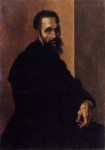 That left Florence the sole power in Italy fighting the combined armies of Spain and the Holy Roman Empire. On October 24th, 1529, Imperial troops laid siege to the city of Florence. The city was not caught unprepared. There had been rumblings since before the treaties that Pope Clement was willing to partner with Charles V if he could get Florence back for his family. The city government decided to implement defense plans from the 1526 Medici administration and created a committee, the Nine of the Militias, to work on city fortifications. Michelangelo Buonarroti was one of the Nine and was soon appointed “governor and general prosecutor of fortifications.”
That left Florence the sole power in Italy fighting the combined armies of Spain and the Holy Roman Empire. On October 24th, 1529, Imperial troops laid siege to the city of Florence. The city was not caught unprepared. There had been rumblings since before the treaties that Pope Clement was willing to partner with Charles V if he could get Florence back for his family. The city government decided to implement defense plans from the 1526 Medici administration and created a committee, the Nine of the Militias, to work on city fortifications. Michelangelo Buonarroti was one of the Nine and was soon appointed “governor and general prosecutor of fortifications.”
His military plans were ambitious, to put it mildly. Michelangelo’s architectural endeavors had a tendency towards grandiose vision which inevitably failed to come to fruition when the money dried up and technological obstacles could not be overcome. Only a few scattered pieces of his large, complex designs were ever built, and none of them have survived. There’s a beautiful design of his fortifications for the Porta al Prato di Ognissanti, one of the city gates, in the permanent collection of Florence’s Casa Buonarroti museum which was until yesterday on display at the Boston Museum of Fine Arts.
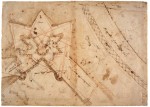 That’s not to say Michelangelo was paralyzed by his own ambition. He set to work on smaller, more practical tasks like adding observation bastions to all the gates and strengthening the city walls with embankments. He managed to measurably improve Florence’s defenses, particularly the strategically important bell tower and hill of San Miniato, despite his own forays into the implausible and the constant interference of his enemies in government. Perhaps the government’s biggest mistake was to appoint Malatesta Baglioni chief commander of Florence’s military. Michelangelo questioned his fidelity, having seen first hand his lazy, desultory efforts in the reinforcement of the city.
That’s not to say Michelangelo was paralyzed by his own ambition. He set to work on smaller, more practical tasks like adding observation bastions to all the gates and strengthening the city walls with embankments. He managed to measurably improve Florence’s defenses, particularly the strategically important bell tower and hill of San Miniato, despite his own forays into the implausible and the constant interference of his enemies in government. Perhaps the government’s biggest mistake was to appoint Malatesta Baglioni chief commander of Florence’s military. Michelangelo questioned his fidelity, having seen first hand his lazy, desultory efforts in the reinforcement of the city.
Michelangelo was right. Baglioni was a traitor from minute one, surrendering Perugia right off the bat without even an attempt at defense. Michelangelo tried to alert the government that Baglioni could not be trusted, but they blew him off. On September 21st, 1529, Michelangelo fled Florence for Venice, his ultimate destination France. The Florentine government declared him an outlaw and confiscated his property, but promised they’d let him off the hook if he came back. He returned on November 20th, just under one month into the siege.
The siege of Florence lasted ten long months. Florence’s military, led by great warrior and national hero Francesco Ferruccio, fought an impressively good fight against Imperial might, but he was broken in the end by a debilitating fever that interrupted his surprise attack, by the short-sightedness and petty conflicts of Florentine government, and by the traitor Malatesta Baglioni who kept the city militia from reinforcing Ferruccio’s men at a key moment. On August 10th, 1530, Florence surrendered.
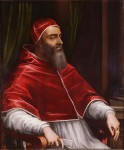 Despite political protections included in the articles of surrender, the Pope immediately got to work arresting and prosecuting Republican patriots. In just one day in October, five anti-Medici citizens were tortured and decapitated. Finally Charles V had to intervene to stop the papal bloodbath. Alessandro de’ Medici, ostensibly the son of Lorenzo II de’ Medici but widely thought to have been the illegitimate son of Pope Clement VII himself, was installed as ruler of Florence.
Despite political protections included in the articles of surrender, the Pope immediately got to work arresting and prosecuting Republican patriots. In just one day in October, five anti-Medici citizens were tortured and decapitated. Finally Charles V had to intervene to stop the papal bloodbath. Alessandro de’ Medici, ostensibly the son of Lorenzo II de’ Medici but widely thought to have been the illegitimate son of Pope Clement VII himself, was installed as ruler of Florence.
Michelangelo had good reason to fear for his own life in this atmosphere. He had opposed the Medici, was one of the Nine, had actively fought against the winning side, and there were false rumors that he had proposed to destroy the Medici palace in which his beloved patron Lorenzo the Magnificent had once entertained him and build in its place the Piazza of the Mules, named after the preponderance of bastards in the Medici line. So he went into hiding for three months.
It was some good hiding, too. For centuries nobody knew where he had gone. Contemporary biographers like artist Ascanio Condivi and historian Benedetto Varchi said he hid in the house of a friend. Michelangelo’s great-grandnephew Filippo Buonarroti thought he had squirreled himself away in the bell tower of San Nicolo’ church. Michelangelo left his mysterious spiderhole in November after the Pope’s retribution fury abated and he let it be known that he would pardon the artist if he would go back to working on the Medici tombs in the New Sacristy of the basilica of San Lorenzo.
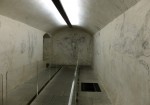 The kicker is Michelangelo only had to walk up a few steps to go from his well-concealed hiding place to resuming his work on the statuary of the Medici Chapel. For those three months, Michelangelo had hidden in a small corridor underneath the New Sacristy. A cramped space just 23 feet long and 6.5 feet wide, this unknown room, which he had doubtless encountered during his earlier work on the Medici tombs, was his solitary confinement prison for three months.
The kicker is Michelangelo only had to walk up a few steps to go from his well-concealed hiding place to resuming his work on the statuary of the Medici Chapel. For those three months, Michelangelo had hidden in a small corridor underneath the New Sacristy. A cramped space just 23 feet long and 6.5 feet wide, this unknown room, which he had doubtless encountered during his earlier work on the Medici tombs, was his solitary confinement prison for three months.
It’s a testament to what a great hidey-hole it was that the corridor wasn’t discovered until 1975 when structural work was being done underneath the Medici Chapel. How did they know it was his 1530 hiding place? Well, what’s a man like Michelangelo to do with nothing but four blank walls to stare at for three months? Make them not blank, of course.
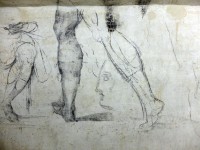
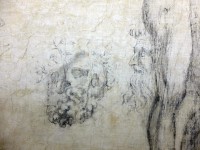
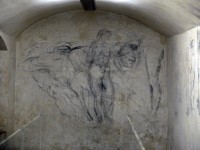
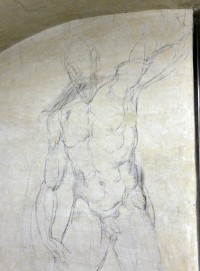
This incredible testimony of a scary, dangerous time in the master’s life has remained almost as secret since its discovery as it was in the centuries preceding. Paolo Dal Poggetto, the director of the Museum of the Medici chapels at the time of the find, decided not to open the small space to the public. The delicate charcoal drawings could not withstand the crush of breathing, sweating, coughing humanity. As always in Italy, it is possible to see them if you know who to ask and plan far ahead, but those are one-off visits. For everyone else in the world, the corridor is now and will remain off-limits.
Thanks to a new multimedia project, high resolution images and video of the drawings will now be viewable by visitors to the Bargello Museum, the Galleria dell’Accademia and in the Basilica of San Lorenzo itself.
Fascinating. Never heard about Michelangelo’s role in Florentine battles (in fact, I never heard about the Florentine resistance to Charles V at all; though I’m familiar in a general sense with both Charles and the chaotic Italian politics). Thanks for sharing.
My pleasure. I knew he had done work on the city defenses and had made enemies, as was his wont, but I didn’t realize until I stumbled on this story how he really put himself on the line for his city. He was 55 by then and not in great health. All that struggle followed by having to hide in a tiny underground chamber for three months must have taken a huge toll.
This is awesome in ways I can’t explain. Hope they keep it off limits to sweaty humanity forever.
Amen. Charcoal drawings can be destroyed with a single exhale. They wouldn’t last long exposed to our grossness every day.
I wonder who delivered food and news to him?
Good question. Perhaps somebody who worked at the church? A cleric of some sort, or a fellow craftsman?
Thanks for this, I had never heard of it either. In answer to who fed him, my guess is that it would have been close family. I don’t think in those days non-family members were generally trusted, especially with one’s life.
So what family? Could have been a brother, although I don;t think he would have trusted Giovan Simone, and more likely than not Buonarroto died the year before. He might have faked it, and a death in 1529 I would have been very suspicious of, but more likely he died in 1528. And Leonardo, wasn’t he dead also? Actually not. He faked it and went to Northern Europe. And that is why Michelangelo didn’t go to his funeral. There wasn’t one to go to. How do I know? We’ll come to that.
But maybe it wasn’t a brother. Michelangelo hid it extraordinarily well, but he had more than a few children. The evidence has been under our noses all along, it’s just we didn’t know how to see it. Take a close look at his drawing of Vittoria Colonna. Apart from the fact that she is holding someone small between her fingers, look closely at where her womb would be. There is a baby there, and he is named. Michelangelo also gives the dates he started (inizio) and completed (perfeito) the drawing, and he started it in 1511, the year the child was born. Who was he? Go look. You will be amazed.
An earlier son he hid in God’s cloud in the Creation of Adam. Look just above the bulge of the uppermost muscle in ‘God’s left arm, and you will find a shadow, just to the right of a cherub. Peer into that shadow for a few moment. Get used to it, let you pattern recognition circuits get to work on it. There is the profile of a face there, and very faintly he wrote the name of the boy there, where his hair should be. And he wrote, vertically towards the back of the head ‘io ti amo’.
He sketched the boy two more that I know of. For Julius’ Tomb, and also as the preparatory sketch for one of the Ignudi – the one that looks horrified at the approach of the white haired gentleman in a red frock in the Separation of the Waters from the Earth (actually the separation of the waters above from the waters below – there’s no earth there, and don’t worry, I’m not being blasphemous, because it’s not God he drew there, but someone much less worthy of our esteem). And that original sketch shows that the boy was not Caucasian. He was African, and his name, he says, was ‘Ali’.
I wonder whose photographs these are and why you didn’t give the photographer credit? I think I know who took these.
Pardon me for the delay in response; I only just saw this. The photographs were taken by Claudio Giovannini for the AFP wire service. The credit is in the hovertext. Is that who you thought the photographer was?
I was one of the sweaty humanity who was fortunate enough to visit “sotterraneo” on two different occasions, a few years apart, in the early 2000s. It was an amazing, intimate experience—only six people were allowed in the chamber at any given time. It was like walking around Michelangelo’s oversized sketchbook, as if Michelangelo had stepped out of the room for a moment just as you walked in.
I have come to this blog late but wanted to add my memories to Thom Tammaro’s. He describes the experience exactly. However, I had the extraordinary opportunity to be in that chamber alone, during the mid-eighties. I had been waiting for the 6 person tour to begin around a corner from the rest of the group, and managed to miss the call to go. Irritable and breathless, I charged along a corridor and arrived just in time to see the group leave the room and the door close in front of me. Crossly, I waved my arms and remonstrated in appalling Italian with the guard; to my utter astonishment, he smiled and shrugged and let me in. And closed the door behind me while he waited outside. Without warning and little comprehension of how to process this unbelievable privilege, I found myself completely alone with Michelangelo. I was just an inexperienced young tourist. No docent, no guide, no explanation. It was extremely quiet. Quite well lit, as I recall. I was simply stunned. Apparently Michelangelo had just stepped out for a sandwich. The sketches seemed to vibrate on the walls, moving and breathing. I have never been so close to living genius in my life. I remember thinking, I could touch these and nobody would know; I could touch Michelangelo. But obviously I didn’t:-) I just walked up and down and up and down, trying to embed the moment in my memory for ever, peering at these live sketches and feeling that it was Michelangelo himself who was allowing me to see them. Fanciful but beyond powerful. As you see, I’m running out of words. I have no idea how long I was in there, but it finally occurred to me that the guard might get suspicious. With indescribably reluctance, I opened the door and walked out. I thanked the guard somewhat shakily, with a very wet face. Again he smiled very understandingly, and I left the building in a daze. I went back to London and did some serious reading on my new friend Michelangelo. My understanding of the utter humanity of art deepened immeasurably after that experience. No need to say how fortunate I still feel to have this treasured memory.
Oh my God, I’m tearing up just from reading about it. What a profound and compelling experience. That is a memory you will doubtless cherish your entire life.
How small did the space feel when you were in there alone? Did it convey a sense of Michelangelo’s confinement and loneliness?
Hello Livius. I have thought a lot about this experience in the last few hours, since posting. It was a long time ago, but I don’t recall feeling confined, perhaps because the room seemed light and very still, and there was on-one else but me present. Except him:-) Also, I had no knowledge of the circumstances that brought Michelangelo to create in that little space. In my ignorance, I thought it was just a place where he worked out his ideas on some friendly and convenient walls. The photo you post is, as I remember, exactly what I saw. It’s startling to see the photographic memory of that afternoon after all this time. I didn’t have a camera, and wouldn’t have had the nerve to use it if I had. My sensation at the time was, as Thom says, of intimacy. Of being close to the man as he expressed his unimaginable imagination. It was like a time machine. Perhaps it would be presumptuous of me to describe these sketches as improvising; obviously Michelangelo’s planning was on a galactic scale. Nonetheless, they did seem so alive and fresh. I’m a pianist and the closest I can get to this is the experience of playing Beethoven’s somewhat improvised concerto cadenzas, which he actually wrote out later for posterity, rather than allow future pianists to butcher his work with their own ideas!
I hope this helps a little. I was sad to learn that the chamber is officially off limits now, although I totally understand why. It really is small. One day perhaps I will be able to visit again and find another friendly guard to let me in…
Whoa… about the Vittoria Colona figure. Not sure I see the baby though, but certainly the small figure pointing to or touching her belly. Can you tell me where to find the drawing of the scared-looking ignudi? Haven’t found the silhouette in the Creation of Adam yet; waiting to go home a get a good look at a high quality print, Thanks a lot.
Hi John
I’ll put a marked up copy of the Vittoria Colonna drawing up on my Facebook page, showing the Vasari reference. I increased the tonal contrast to make the letters clearer, and I’ve used an ‘alternate letter’ method of helping locate them – there’s so much ‘noise’ here they are a real challenge to make out, and this is complicated by the fact that Michelangelo also wrote the word ‘Vasari’ several times, using different sequences of letters. The ‘S’ for example, shown here, in another sequence reads as an R.The ambiguity is easy to see.
Apart from this I’ve traced the dates he started (‘inizio’), and finished (‘perfetto’) the drawing. Looks like 1511 start, with Vittoria’s pregnancy with Vasari, and finished (1526) the year after Vittoria’s husband died. Indeed, I suspect (but I’m much less certain) that he also wrote ‘liberta 25’ over the mannequin, suggesting that he saw Vittoria now liberated to be his lover. (In a portrait of her husband, I also suspect the word ‘arsenico’, but being an engraving, it’s even harder to tell.)
I’ll also put up a good version of the shocked ignudo, and the sketch he based it on, actually of Ali. You can see that the face on the sketch is not Caucasian, and he changed it when painting the boy on the Sistine Chapel ceiling. This was because the lad in the painting was not representing Ali, but Michelangelo’s nephew, who was having some problems avoiding unwelcome interest from Pope Julius (the guy in the pink frock is not God!). I’ll also put up the image of Ali in the cloud of red drapery, again marked up to make it easier to see in the shadows.
The Facebook page is under my pen name:
http://www.facebook.com/people/Peter-Merlin-Cane/100005666594877
Look forward to your thoughts!
I’d like to share with you a lost painting
http://dexxxaa.picturepush.com/album/353950/p-Micheleangelo.html
Speaking of Michelangelo, Have you wondered if there are hidden costs in displaying major works of art! >>> http://segmation.com/blog/2015/09/15/are-there-hidden-costs-in-displaying-major-works-of-art/ 😉
Great to read more about this time in Michelangelo’s life. Must have been terrifying. Wonderful to see the drawings! Thank you!!
From the look of that fortress plan we may give Vauban too much credit!
Wow, I didn’t know they closed this off…..we were lucky to have visited in 2002, one of the highlights of our trip to Florence! I remember buying a “pink” ticket with an appointed time, at that time we presented it to a guard in a doorway and he opened the trap door into the cellar……we descended (just the 2 of us) into that amazing room! The drawings were as fresh as if Michaelangelo had just left the room, I was speechless!